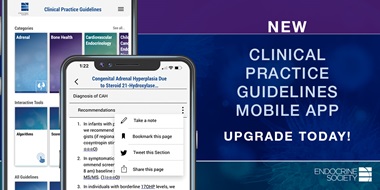Full Guideline: Testosterone Therapy in Men With Hypogonadism: An Endocrine Society Clinical Practice Guideline
JCEM | March 2018
Shalender Bhasin, Juan P. Brito, Glenn R. Cunningham, Frances J. Hayes, Howard N. Hodis, Alvin M. Matsumoto, Peter J. Snyder, Ronald S. Swerdloff, Frederick C. Wu, Maria A. Yialamas
Differences between the 2010 and 2018 guidelines:
- More rigorous appraisal of testosterone’s efficacy and safety using RCTs published during the last three years.
- Points out continuing uncertainty about the benefits and risks of testosterone therapy as well as suboptimal testosterone prescribing practices.
- Highlights the importance of an appropriate diagnostic work up and monitoring plan.
Diagnosis and Treatment of Male Hypogonadism | ENDO 2018
Essential Points
- Recommends making a diagnosis of hypogonadism only in men with symptoms and signs consistent with testosterone (T) deficiency and unequivocally and consistently low serum T concentrations.
- Recommends the use of accurate assays for the measurement of total and free testosterone and rigorously derived reference ranges for the interpretation of testosterone levels.
- Recommend confirming the diagnosis by repeating the measurement of morning fasting total T concentrations.
- In men determined to have androgen deficiency, we recommend additional diagnostic evaluation to ascertain the cause of androgen deficiency.
- We recommend against starting T therapy in patients who are planning fertility in the near term or have any of a number of specified conditions.
Summary of Recommendations
+1.0 Diagnosis of Hypogonadism in Men
1.1 We recommend diagnosing hypogonadism in men with symptoms and signs of testosterone deficiency and unequivocally and consistently low serum total testosterone and/or free testosterone
concentrations (when indicated). (1 |ꚚꚚꚚO)
1.2 We recommend against routine screening of men in the general population for hypogonadism.
(1 |ꚚꚚOO)
1.3 In men who have hypogonadism, we recommend distinguishing between primary (testicular) and secondary (pituitary–hypothalamic) hypogonadism by measuring serum luteinizing hormone and follicle stimulating hormone concentrations. (1 |ꚚꚚꚚO)
1.4 In men with hypogonadism, we suggest further evaluation to identify the etiology of hypothalamic, pituitary, and/or testicular dysfunction. (2 |ꚚꚚOO)
+2.0 Treatment of Hypogonadism with Testosterone
2.1 We recommend testosterone therapy in hypogonadal men to induce and maintain secondary
sex characteristics and correct symptoms of testosterone deficiency. (1 |ꚚꚚꚚO)
2.2. We recommend against testosterone therapy in men planning fertility in the near term or in men with breast or prostate cancer, a palpable prostate nodule or induration, a prostate-specific antigen level >4 ng/mL, a prostate-specific antigen level >3 ng/mL combined with a high risk of prostate cancer
(without further urological evaluation), elevated hematocrit, untreated severe obstructive sleep apnea,
severe lower urinary tract symptoms, uncontrolled heart failure, myocardial infarction or stroke within
the last 6 months, or thrombophilia. (1 |ꚚꚚOO)
2.3 In hypogonadal men 55 to 69 years old, who are being considered for testosterone therapy and
have a life expectancy >10 years, we suggest discussing the potential benefits and risks of evaluating
prostate cancer risk and prostate monitoring and engaging the patient in shared decision making
regarding prostate cancer monitoring. For patients who choose monitoring, clinicians should assess
prostate cancer risk before starting testosterone treatment and 3 to 12 months after starting testosterone. (2 |ꚚOOO) In hypogonadal men being considered for testosterone therapy who are 40 to
69 years old and at increased risk of prostate cancer (e.g., African Americans and men with a first-degree
relative with diagnosed prostate cancer), we suggest discussing prostate cancer risk with the patient and
offering monitoring options. (2 |ꚚOOO)
2.4 We suggest against routinely prescribing testosterone therapy to all men 65 years or older with
low testosterone concentrations (1 |ꚚꚚOO). In men.65 years who have symptoms or conditions
suggestive of testosterone deficiency (such as low libido or unexplained anemia) and consistently
and unequivocally low morning testosterone concentrations, we suggest that clinicians offer
testosterone therapy on an individualized basis after explicit discussion of the potential risks and
benefits. (2 |ꚚꚚOO)
2.5 We suggest that clinicians consider short-term testosterone therapy in HIV-infected men with low testosterone concentrations and weight loss (when other causes of weight loss have been excluded)
to induce and maintain body weight and lean mass gain. (2 |ꚚꚚOO)
2.6 In men with type 2 diabetes mellitus who have low testosterone concentrations, we recommend
against testosterone therapy as a means of improving glycemic control. (1 |ꚚꚚOO)
+3.0 Monitoring of Testosterone Replacement Therapy
3.1 In hypogonadal men who have started testosterone therapy, we recommend evaluating the patient after treatment initiation to assess whether the patient has responded to treatment, is suffering any adverse effects, and is complying with the treatment regimen. (Ungraded Good Practice Statement)
3.2 We recommend a urological consultation for hypogonadal men receiving testosterone treatment
if during the first 12 months of testosterone treatment there is a confirmed increase in prostate specific
antigen concentration >1.4 ng/mL above baseline, a confirmed prostate-specific antigen >4.0 ng/mL, or a prostatic abnormality detected on digital rectal examination. After 1 year, prostate monitoring should conform to standard guidelines for prostate cancer screening based on the race and age of the patient. (2 |ꚚꚚOO)

